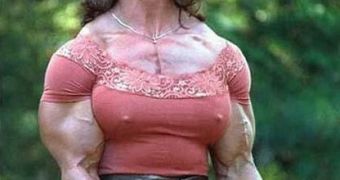From an eyebrow trembling to jumping, all is made by the muscles. Without them we could not even digest food or circulate blood inside the body.
1.There are three types of muscles: skeletal, responsible for the voluntary movements (from a smile to climbing the stairs); smooth, which make slow, involuntary movements of the inner organs (intestine or bladder, for example) and heart muscle.
The skeletal muscles make 25 % of the bodyweight even in the case of newborn. The smallest muscle of the human body is stapedius, found in the inner ear, which is no larger than a needle tip.
2.Skeletal muscles fix on the bone with tendons. Of the two fixing ends, one is called origin, and the other terminal insertion. The tendon from which a muscle starts is shorter than the tendon that fix it on the bone. The origin is proximal, the terminal insertion is distal.
The starting point is on one part of an articulation, and the fixing point on the other, so that the contraction of the muscle changes the position of the two bones making the articulation.
3.The skeletal muscles are made of bunches of filaments. The thinnest filaments, seen only with an electronic microscope, are called myofilaments and are made of two types of contractile proteins: actin and myosin. A muscle contracts when the myosin filaments slip on actin filaments. Myofilaments organize in myofibriles.
Amongst the myofibriles are found glycogen granules, "fuel stores" for the muscle, and mitochondria, "energetic centrals" of the muscle. The mitochondria burn the food chemicals, releasing and storing their energy.
4.Myofibriles organize in muscle fibers, which are the muscle cells. They have various nuclei located near the membrane. To each muscle fiber is connected a nervous fiber which transmits commands for the muscle to contract.
Muscle fibers gather in larger fascicles, wrapped in conjunctive tissue, like the isolation of a copper cable. Smaller muscles contain a few fascicles, but larger ones contain hundreds.
The nervous fibers connect to the muscle cells through motor plates. The nerves do not act directly on the muscles, but through the motor plate it is released acetylcholine that transfers the excitation.
5.The slipping of myosin on actine requires energy, delivered by ATP, a molecule formed when mitochondria burn chemicals (especially glucose, and the glycogen is just a glucose polymer, like starch in plants).
6.There are also two other types of fibers in the muscle: one registers the contraction force, the other type measures the stretching tension appeared in tendons. These two types of information are delivered to the brain, and this is very important in how we control our muscles.
7.Many muscles work in tandem. For example, in the case of the arm, the biceps flexes the forearm, while the triceps extends the forearm.
8.Contractile muscle cells are of two types: fast-twitch fibers contract quickly for infrequent bursts of activity. This is the case of the body builders. Durable slow-twitch fibers are employed for regular, extended periods of activity. This is the case of the workers.
9.Cell muscles contain myoglobin, a protein similar to hemoglobin, the iron-containing molecule that gives blood its red color and transports oxygen. Myoglobin too has an affinity for oxygen. Myoglobin delivers to the mitochondria oxygen and when there is no more oxygen, the muscles turn tired. Muscles that are employed more regularly have higher amounts of myoglobin. More myoglobin gives the darker color of the meat.
This explains why the farm chickens have whiter meat than yard grown chickens, and why the chest meat of domestic chickens, which do not fly, is whiter than the chest muscles of the flying birds; also, why the game meat is darker (wild animals move much more than the domestic ones). Different levels of myoglobin between species explain the difference in meat colors.

 14 DAY TRIAL //
14 DAY TRIAL //